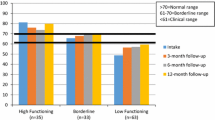Abstract
We examined whether clinical progress ratings on the Monthly Treatment and Progress Summary form (MTPS), an idiographic treatment progress measure, were meaningfully related to changes measured by two separate standardized instruments; the Child and Adolescent Functional Assessment Scale (CAFAS) and the Child and Adolescent Level of Care Utilization System (CALOCUS). Validity coefficients were examined at intake and three-, six-, and nine-month follow-up periods. Samples were selected for each measure and follow-up period from the population of youth receiving services through the Hawaii Child and Adolescent Mental Health Division’s (CAMHD) system of care. Significant youth improvement was evident on all three measures across all follow-up intervals. The type of changes measured by the MTPS and CAFAS were more alike over longer follow-up intervals than changes measured by the CALOCUS. The MTPS captures distinct aspects of client change that overlaps somewhat with CAFAS and CALOCUS measures. The MTPS is a brief client-tailored measure that seems to provide valid, sensitive, and nonredundant client specific treatment outcome information that can be collected on a frequent basis within a complex system of care.

Similar content being viewed by others
References
Achenbach, T. M., & Rescorla, L. A. (2001). Manual for the ASEBA school-age forms and profiles. Burlington, VT: University of Vermont, Research Center for Children, Youth, & Families.
American Academy of Child and Adolescent Psychiatry & American Association of Community Psychiatrists (1999). Child and Adolescent Level of Care Utilization System: User’s Manual.
Battle, C., Imber, S., Hoehn-Sario, A., Nash, E., & Frank, J. (1966). Target complaints as criteria of improvement. American Journal of Psychotherapy, 20, 184–192.
Callaghan, G. M. (2001). Demonstrating clinical effectiveness for individual practitioners and clinics. Professional Psychology: Research & Practice, 32, 289–297.
Child and Adolescent Mental Health Division (2003). Instructions and codebook for provider monthly summaries. Honolulu, HI: Hawaii Department of Health Child and Adolescent Mental Health Division.
Cohen, J. (1988). Statistical power analysis for the behavioral sciences (2nd edn.). Hillsdale, NJ: Lawrence Earlbaum Associates.
Fallon, T., Pumariega, A., Sowers, W., Klaehn, R., Huffine, C., et al. (2006). A level of care instrument for children’s systems of care: Construction, reliability, and validity. Journal of Child and Family Studies, 15, 143–145.
Garland, A. F., Kruse, M., & Aarons, G. A. (2003). Clinicians and outcome measurement: What’s the use? Journal of Behavioral Health Services & Research, 30, 393–405.
Hodges, K. (1995). CAFAS: Self-training manual. Ann Arbor, MI: Functional Assessment Systems.
Hodges, K. (1998). Child and Adolescent Functional Assessment Scale (CAFAS). Ann Arbor, MI: Functional Assessment Systems.
Hodges, K., & Wong, M. M. (1996). Psychometric characteristics of a multidimensional measure to assess impairment: The Child and Adolescent Functional Assessment Scale (CAFAS). Journal of Child and Family Studies, 5, 445–467.
Kiresuk, T. J., Smith, A., & Cardillo, J. E. (1994). Goal attainment scaling: Applications, theory, and measurement. Hillsdale, NJ, England: Lawrence Erlbaum Associates, Inc.
Mintz, J., & Kiesler, D. (1982). Individualized measures of psychotherapy outcome. In P. Kendall & J. Butcher (Eds.), Handbook on research methods in clinical psychology. New York: John Wiley & Sons.
Ottenbacher, K., & Cusick, A. (1990). Goal attainment scaling as a method of clinical service evaluation. American Journal of Occupational Therapy, 44, 519–525
Rosnow, R. L., & Rosenthal, R. (1996). Computing contrasts, effect sizes, and counternulls on other people’s published data: General procedures for research consumers. Psychological Methods, 1, 331–340.
Stroul, B., & Friedman, R. M. (1994). A system of care for children and youth with severe emotional disturbances. Washington, DC: Georgetown University Child Development Center, CASSP Technical Assistance Center.
Acknowledgments
This research was produced through the collaborative efforts of the many youth, families, and professionals who contribute to the Hawaii system of care for child and adolescent mental health. Particular thanks are due to Bruce Chorpita, Christina Donkervoet, and Ryan Tolman for their many contributions. This project was supported through a Research and Evaluation Training grant from the Hawaii Department of Health.
Author information
Authors and Affiliations
Corresponding author
Rights and permissions
About this article
Cite this article
Nakamura, B.J., Daleiden, E.L. & Mueller, C.W. Validity of Treatment Target Progress Ratings as Indicators of Youth Improvement. J Child Fam Stud 16, 729–741 (2007). https://doi.org/10.1007/s10826-006-9119-9
Published:
Issue Date:
DOI: https://doi.org/10.1007/s10826-006-9119-9




